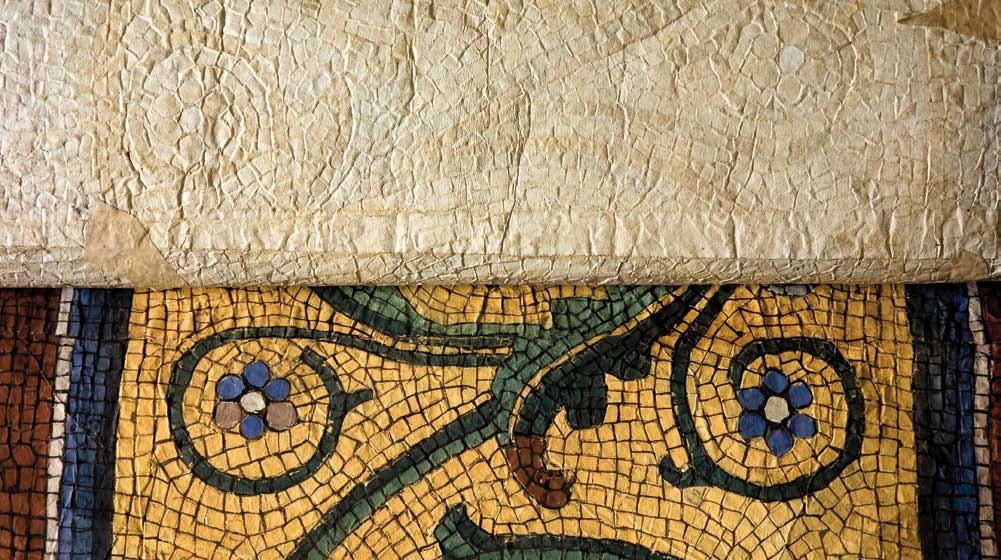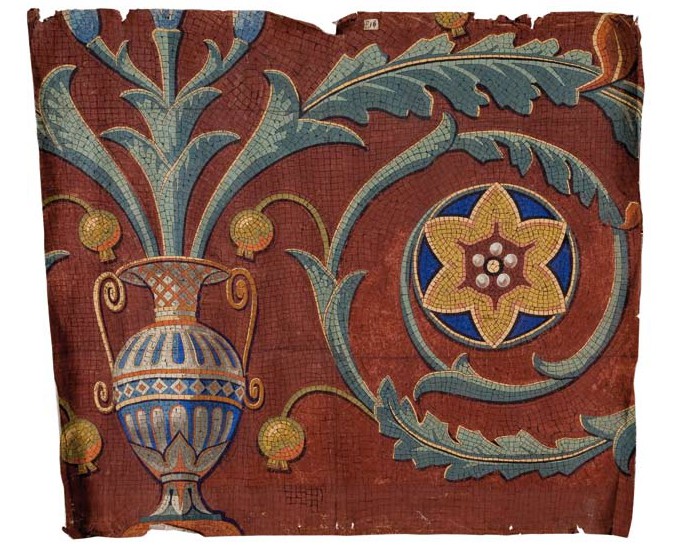Colorful Mosaic Molds (Prints) from the Apse of St. John Lateran
Artist: Domenico Bartolini, Oreste Ricceri
Date: 1884
Classification: Print
Dimensions: Various
Materials: Tempera on colored paper
Adopted By: The Minnesota & North Dakota Chapter
Total Cost: € 16,815
Description
During the pontificate of Leo XIII, the Canons of the Basilica of St. John Lateran recognized the necessity for a larger choir and so it was decided to reconstruct the apse according to the ancient form of the basilica. Construction took place from 1884 to 1886 under the direction of the architect Virginio Vespignani assisted by his son, Francesco.
The mosaics decorating the apse at the time were installed by Jacopo Torriti and his collaborator Jacopo da Camerino in 1291 under the
the papacy of Nichols IV (1288-1292). Before removing these, the restorers Domenico Bartolini and Oreste Ricceri divided the mosaic into fifty-centimeter blocks, and casts of all the mosaic decorations were made in tempera on colored paper. Divided as such, the mosaic sections were removed and each section was heavily restored. Unfortunately, the original artistic style of the work was lost and the casts made are our only living documentation of the appearance of the original apse.
After the expansion of the apse, the restored mosaic was reinstalled in order to preserve the iconographic composition of the medieval
mosaics. At the center of the splendid basin, we find the gemmed cross on the paradisiacal mountain between the Virgin and Saint John the Baptist accompanied by three saints. At the summit of the apse on a background of clouds and encircled by angels is the image of
the Savior; in the semicircle between the windows, nine apostles are depicted surrounded by fruit-laden trees.
The casts were created in a one-to-one ratio by laying large sheets of heavy newspaper directly onto the mosaic which perfectly affixed to the original when pressed with a damp sponge. This technique, “mosaic tesserae,” reproduced the image on paper, as evident when examining the back of the casts. The more subtle shades of color were then carefully painted over by hand in tempera. These casts are therefore a very useful instrument to obtain lost information about the original mosaics which were lost in the abusive restoration. Metal spikes of the casts, in fact, were also recopied to consolidate the surfaces for the tesserae and the main dimensions while the restores filled in the holes.
On the casts, the imprints of the metal spacers employed to stabilize the mosaic, as well as the prints of some larger tesserae, were used to fill in the gaps during restoration. The original tesserae of the mosaics were in fact smaller, carefully created and made with a richness of color and tonality that reminds us of the mosaics created by the Torriti in the apse of St. Mary Major. In 1986 the casts of mosaics in the apse of St. John Lateran became a part of the Vatican Museums Collection. Of the total of 158 casts received, to date, only 42 have been restored. 18 have been selected for restoration and were chosen as representative samples of various sections of the apse. Among the decorative motifs chosen were: the stylized papaya trees that fill the space between the windows; the simple golden background and the different decorative friezes of vegetables or geometric shapes; and the figures draped with the names of the Apostles inscribed in mosaic tesserae with on gold background.
State of Preservation
There is a thick layer of dust causing the colors to be dull. There are gaps and missing paint as well as tears in the paper. Previous restorations and old glue are causing problems on the paper. The backing of the prints is not stable and further damages the paper. The work consists of restoring 15 molds.
Restoration Procedures
- Dust suction and micro-dust suction
- Reintegration of colors
- Removal of old, crystallized glue
- Closing the tears with Japanese paper
- and special glue
- Retouching of the pictorial surface and
- filling of gaps with Japanese paper and
- watercolors
- Reinforcement of the edges
- New stabilizing support
- Photographic documentation
Detail
Adopted By:
The Minnesota & North Dakota ChapterArtist: Domenico Bartolini, Oreste Ricceri
Date: 1884
Provenience: St. John Lateran
Dimensions: Various
Materials: Tempera on colored paper
Wishbook year: 2012
Total Cost
€ 16,815

Colorful Mosaic Molds (Prints) from the Apse of St. John Lateran

Details
Adopted by: The Minnesota & North Dakota Chapter
Artist: Domenico Bartolini, Oreste Ricceri
Date: 1884
Provenience: St. John Lateran
Classification: Print
Materials: Tempera on colored paper
Dimensions: Various
Department: XV-XVI Century Art
Laboratory: Paper
Wishbook year: 2012
Description
During the pontificate of Leo XIII, the Canons of the Basilica of St. John Lateran recognized the necessity for a larger choir and so it was decided to reconstruct the apse according to the ancient form of the basilica. Construction took place from 1884 to 1886 under the direction of the architect Virginio Vespignani assisted by his son, Francesco.
The mosaics decorating the apse at the time were installed by Jacopo Torriti and his collaborator Jacopo da Camerino in 1291 under the
the papacy of Nichols IV (1288-1292). Before removing these, the restorers Domenico Bartolini and Oreste Ricceri divided the mosaic into fifty-centimeter blocks, and casts of all the mosaic decorations were made in tempera on colored paper. Divided as such, the mosaic sections were removed and each section was heavily restored. Unfortunately, the original artistic style of the work was lost and the casts made are our only living documentation of the appearance of the original apse.
After the expansion of the apse, the restored mosaic was reinstalled in order to preserve the iconographic composition of the medieval
mosaics. At the center of the splendid basin, we find the gemmed cross on the paradisiacal mountain between the Virgin and Saint John the Baptist accompanied by three saints. At the summit of the apse on a background of clouds and encircled by angels is the image of
the Savior; in the semicircle between the windows, nine apostles are depicted surrounded by fruit-laden trees.
The casts were created in a one-to-one ratio by laying large sheets of heavy newspaper directly onto the mosaic which perfectly affixed to the original when pressed with a damp sponge. This technique, “mosaic tesserae,” reproduced the image on paper, as evident when examining the back of the casts. The more subtle shades of color were then carefully painted over by hand in tempera. These casts are therefore a very useful instrument to obtain lost information about the original mosaics which were lost in the abusive restoration. Metal spikes of the casts, in fact, were also recopied to consolidate the surfaces for the tesserae and the main dimensions while the restores filled in the holes.
On the casts, the imprints of the metal spacers employed to stabilize the mosaic, as well as the prints of some larger tesserae, were used to fill in the gaps during restoration. The original tesserae of the mosaics were in fact smaller, carefully created and made with a richness of color and tonality that reminds us of the mosaics created by the Torriti in the apse of St. Mary Major. In 1986 the casts of mosaics in the apse of St. John Lateran became a part of the Vatican Museums Collection. Of the total of 158 casts received, to date, only 42 have been restored. 18 have been selected for restoration and were chosen as representative samples of various sections of the apse. Among the decorative motifs chosen were: the stylized papaya trees that fill the space between the windows; the simple golden background and the different decorative friezes of vegetables or geometric shapes; and the figures draped with the names of the Apostles inscribed in mosaic tesserae with on gold background.
State of Preservation
There is a thick layer of dust causing the colors to be dull. There are gaps and missing paint as well as tears in the paper. Previous restorations and old glue are causing problems on the paper. The backing of the prints is not stable and further damages the paper. The work consists of restoring 15 molds.
Restoration Procedures
- Dust suction and micro-dust suction
- Reintegration of colors
- Removal of old, crystallized glue
- Closing the tears with Japanese paper
- and special glue
- Retouching of the pictorial surface and
- filling of gaps with Japanese paper and
- watercolors
- Reinforcement of the edges
- New stabilizing support
- Photographic documentation
Media

Colorful Mosaic Molds - 1

Colorful Mosaic Molds

© 2025 Patrons of the Arts
in the Vatican Museums
Vatican Museums V-00120,
Vatican City State (Europe)
+39 0669864499
